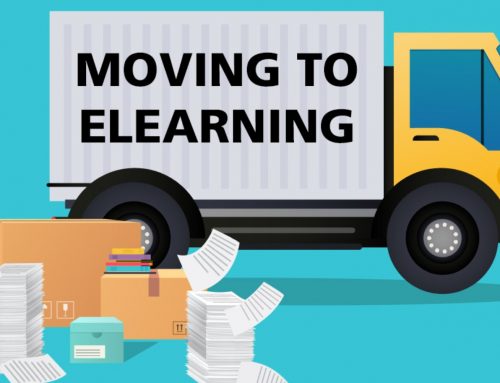When dealing with training, education, and marketing solutions, it doesn’t take long before we start hearing words we may not know. Below is a list of 20 common terms and definitions.
- Analytics
Refers to the analysis and derivation of data into usable information or statistics. Analytics are often presented visually or numerically and are used to understand your audience, where they are succeeding, where they are failing, your site’s use, and any other number of variables.
- Animation
Animation can be broken into two areas. First, it can be presented as 2d or 3d, and in a realistic or stylized representation of objects, people, and places. They take place over time and are often used to visually describe a story, a theory, an idea, a process, a feature, or a benefit. Second, animation can be used within a user interface to lead the user’s eye to focus on something specific or guide them to the next section within a course. The iPhone is a good example of this.
- Avatar
A virtual representation of a user. Avatars take on many styles such as cartoons, real photos, and even an image of a favorite sport, hobby, pet, or event. Avatars can help users customize their experience and interact with others.
- Audience
An audience is a group of users and often stands for a single user. A user can be a student, participant, and administrator.
- Blended Learning
A learning approach that blends or merges several different methods or types of learning together to form a cohesive experience. Blended learning could take a distance learning based course component, a live learning event, and an interactive virtual challenge and develop them into one user experience.
- Brand
Brands set the overall look and feel of a company, site, application, or other entity. They represent the values of the community, culture, and objectives through images, colors, shapes, logos, and layouts. Brand can go much deeper than visual ques alone and can effect how a company acts towards each other and other companies, how they develop ideas, etc. Brand recognition occurs when a company, like Apple, Nike, Google, and BMW are recognized by their brand and brand elements.
- Chunking
Involves the development of content and other materials into short, brief, bite size pages and sections that can focus the user facts, theories, processes, and ideas to increase their understanding and retention.
- Content Management Systems (CMS)
Application for delivering, tracking, and managing content and communication.
- Engage and Engaging
Refers to a user’s favored interest in a website, component, and experience. An engaging experience often refers to an experience that immerses the user in materials or an environment. Engaging experiences often lead the user through text, video, animation, challenges, games, communication, or 3d environments.
- Facilitator
A course instructor, teacher, or helper who aids training and learning in an online, student based environment.
- Haptics
Input device that provides forced feedback to add a sense based approach to interaction. Haptics can range from a vibration pack in a game controller to a laparoscopic tool that hooks to a virtual 3d patient. See our post on Haptics.
- Information Architecture
Deals with the structure, management, layout, organization, and categorization of content. It allows users to more efficiently and effectively find information and work through information. It also provides methods for loading information faster.
- Instructional Designer (ID)
Someone who practices instructional learning theories to streamline experiences and courses by tailoring them to a specific group of users and audiences.
- Interactive
A hands-on ability to change and explore an object within an environment. Interactivity usually provides feedback to an interaction. With interactivity users can play with an iPhone without buying one, click and drag a scalple to make a virtual incision to learn surgery, and can move sliders around to adjust colors on a website.
- Learning Management System (LMS)
Application for delivering, tracking, and managing content and assessments for training and education. An LMS acts as a foundation for information and materials that make up a course or curriculum. For the user, it provides for navigation, the process of learning, and assessment tools. For the administrator, it provides the ability to add/adjust content and review reports on all aspects of the user and the site’s use. SCORM is often used as a platform to plug-in 3rd party and custom made courses and tools.
- Metaphor
Is the virtual, often stylistic, representation of a real life thing or interaction. In a computer, windows on a desktop, file folders, painting in an image editor are all examples of navigational and interactive components that derived from their real life counterparts. Metaphors are used often as users often find them intuitive because they can quickly find a relationship to what they already know.
- Personas
Fictitious characters who represent unique groups of users. Personas are used to understand how different groups of users will use a website or application. By focusing on how a persona interacts with a website, navigates to content and through content, understands and retains the content, we can begin to understand the different user experiences that occur. See our post on Personas.
- Virtual
A non-physical representation of a person, environment, object, or situation. Virtual solutions allow users to interact or train with others in a simulated or made-up environment. Marketing uses virtual solutions often. If you want to buy a car you can visit their website, view and interact with the car, change it’s characteristics, and drive it without ever seeing or touching the real thing.
- User Centered Design (UCD)
Design philosophy which focuses on the goals, objectives, needs, and limitations of the client and the audience. UCD integrates into a development process by specifically detailing and exploring approaches that fulfil the goals and objectives.
- User Experience (UX)
The experience a user receives when interacting with a product, service, or idea. It is how these interactions are perceived, how they are used, and how information is gathered. See our post on the User Experience.
More to come. And let us know what terms we have not yet added!





